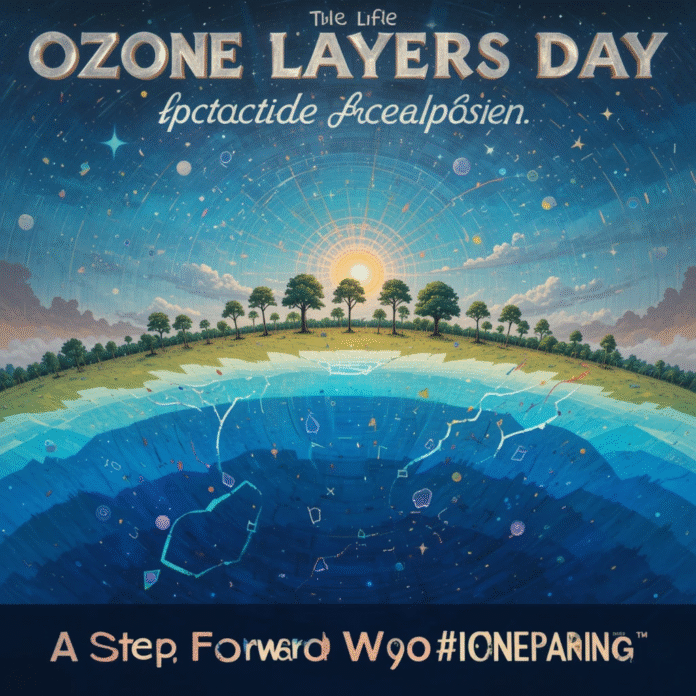Introduction: The Significance of Ozone Layer Day
Ozone Layer Day, observed annually on September 16, serves as a crucial reminder of the efforts made to protect our planet’s fragile atmosphere. Established in 1994, this day commemorates the signing of the Montreal Protocol in 1987, a landmark treaty aimed at phasing out substances responsible for ozone depletion. The ozone layer, located in the stratosphere, plays a vital role in shielding the Earth from the sun’s harmful ultraviolet (UV) radiation, which can lead to detrimental health and environmental effects. Recognizing the significance of this layer has been an essential part of global climate action.
The urgency to address ozone depletion became apparent in the late 20th century, when scientists began to document alarming decreases in ozone concentration. With a multitude of research supporting these findings, the international community recognized the need for a concerted global response. The Vienna Convention for the Protection of the Ozone Layer marked the beginning of collaborative efforts, followed by the more comprehensive Montreal Protocol, engaging various nations in a united front. These agreements not only outlined specific targets for reducing ozone-depleting substances but also fostered scientific collaboration to monitor and assess atmospheric changes.
Today, Ozone Layer Day serves a dual purpose: it celebrates the successes achieved through international cooperation while highlighting the ongoing challenges faced in environmental conservation. As climate change continues to impact the ozone layer and other environmental aspects, this day offers an opportunity to reflect on past achievements and educate communities about the importance of sustained action. Advocacy for ozone layer protection remains critical, as the lessons learned from global responses provide valuable insights into addressing contemporary issues, such as climate change and biodiversity loss.
A Milestone of Progress: Healing of the Ozone Layer
The ozone layer, a vital component of Earth’s atmosphere, has witnessed remarkable recovery since the adoption of international agreements aimed at its protection. The Montreal Protocol, established in 1987, set forth a framework for global cooperation to eliminate the production and consumption of ozone-depleting substances. This landmark treaty has successfully prompted nations around the world to take significant action, demonstrating that collective efforts can yield substantial environmental benefits.
Scientific assessments indicate that the ozone layer is on track to recover to its pre-1980 levels by the middle of the 21st century. This recovery has been attributed to the commitment of nearly 200 countries in adhering to the Protocol, alongside advancements in monitoring technologies that enhance our understanding of atmospheric dynamics. Studies have shown that the reduction in harmful substances, such as chlorofluorocarbons (CFCs), has allowed the stratosphere to stabilize, leading to a decrease in ozone depletion processes. The observed increase in ozone concentrations serves as a testament to the efficacy of international collaboration against environmental challenges.
Moreover, the healing of the ozone layer presents a hopeful narrative in the face of pressing climate issues. It highlights that committed global action can indeed address environmental crises effectively. However, it is crucial to maintain vigilance and continue supporting recovery efforts. Climate change remains a complex issue, and the interconnectedness of environmental systems means that a healthy ozone layer is not merely an isolated victory but part of a broader ecosystem that requires ongoing attention and action. Sustained public awareness and adherence to international protocols are essential for ensuring the continued recovery of this critical layer and safeguarding the planet for future generations.
Current Climate Threats: The Urgency of Action
The current state of the climate presents alarming threats that necessitate immediate and collective action. Scientific research highlights a concerning trend whereby global temperatures are on course to exceed the 1.5°C mark above pre-industrial levels. This threshold is not merely a statistic; it signifies a critical point beyond which the risks of catastrophic climate impacts significantly increase. Rising temperatures lead to more frequent and severe weather events, including hurricanes, droughts, and wildfires, which subsequently threaten ecosystems, agriculture, and human livelihoods.
Additionally, the continuous increase in anthropogenic greenhouse gas emissions remains a significant concern. Carbon dioxide (CO2) and methane (CH4) emissions have been rising at an alarming rate due to industrial activities, deforestation, and energy production. This rising concentration of greenhouse gases in the atmosphere exacerbates the greenhouse effect, leading to accelerated warming and climate instability. In particular, the role of hydrofluorocarbons (HFCs) must be addressed, as these substances contribute to global warming potential significantly higher than that of carbon dioxide.
The consequences of inaction are dire. Without effective climate policies, we risk crossing tipping points that could result in irreversible damage to our planet’s systems. Scientific models predict scenarios where ecosystems collapse, sea levels rise dramatically, and weather patterns become increasingly erratic. Such shifts will disproportionately affect vulnerable populations, exacerbating social inequalities and leading to potential displacement and conflict over resources.
In order to mitigate these threats, nations must collectively commit to reducing greenhouse gas emissions and phasing out HFCs. The urgency of action is underscored not only by scientific consensus but also by the lived experiences of communities already facing the brunt of climate change. It is imperative that governments worldwide prioritize robust climate policies and engage in international cooperation to foster sustainable solutions, ultimately safeguarding our planet for future generations.
The Way Forward: Commitment to the Kigali Amendment
The Kigali Amendment, adopted in 2016, represents a monumental step forward in the global fight against climate change and the recovery of the ozone layer. By committing to phase down hydrofluorocarbons (HFCs)—chemical compounds that contribute significantly to global warming—countries are taking proactive measures to mitigate their environmental impact. The ratification and implementation of the Kigali Amendment is not only a legal obligation but a moral imperative for nations around the world.
Aligning national climate plans with the objectives of the Kigali Amendment is essential for effective climate action. Countries can adopt tailored strategies that emphasize reducing HFC consumption while concurrently promoting the development and use of alternative substances. This alignment enhances the synergy between local policies and the broader international climate agreements, including the Paris Agreement, thereby facilitating a more cohesive response to the climate crisis. The reduction of HFCs can contribute to averting an estimated 0.5°C rise in global temperatures by the end of the century, making it a critical component of climate recovery efforts.
Every effort counts in the fight against climate change. It is important to recognize that even incremental actions can lead to a significant cumulative impact. Citizens can support the Kigali Amendment through various means, such as advocating for sustainable practices, reducing energy consumption, and promoting awareness about the dangers of HFCs. By understanding their role in this collective journey, individuals can contribute to the larger goal of a sustainable future, reinforcing the need for unity in this global challenge. The call to action is clear: countries must fully commit to the Kigali Amendment, and individuals must engage actively in climate-positive behaviors, ensuring that every action taken leads us closer to a restored ozone layer and a balanced climate system.


